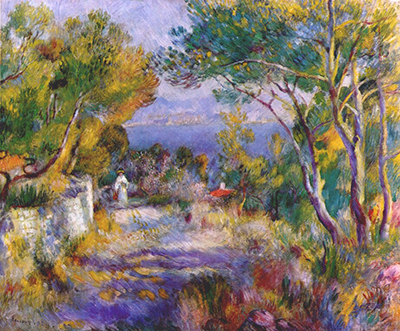L'Estaque is a location in the South of France, not far from the city of Marseilles. In the early 1880s, the Impressionist artist Renoir stayed there with his fellow artist Paul Cezanne.
L'Estaque bears a signature on it stating that Renoir completed this work in '82 - i.e. 1882. This work of art is thus a document of Renoir's stay in L'Estaque and a beautiful piece that can be appreciated in its own right, regardless of the viewer's knowledge of its context. Cezanne is just one of the other artists that Renoir spent time with, painting and sociialising. Like Renoir, Cezanne was French and he was also famous for his beautiful paintings of landscapes, using jewel like green colours to evoke the beauty of the majestic hills in the southern French countryside. Though Renoir and Cezanne had both been influenced by the dominant Impressionist art movement at the time (which artists such as Monet had popularised from the mid 1870s onwards in particular), both of them took their own routes away from Impressionism and developed their own style.
Cezanne, for example, became known as a Post Impressionist painter. Post Impressionism aimed to move away from the naturalistic focus on depicting light and colours that characterised the Impressionist movement. Instead, Post Impressionists favoured a more abstract, and even symbolic, style of painting. As a result, Post Impressionism would give birth to several congruent art movements which took this abstract and non naturalistic method of painting even further, including Symbolism and Fauvism (or the 'bestial' style in painting). In the 1880s, though Cezanne's paintings were not veering too wildly in the direction of the abstract and the symbolic: his landscapes were still recognisable as landscapes.
In L'Estaque we can see that Renoir and Cezanne were working in harmony - Renoir too was engaged in a period of exploring new ways in depicting light and harmonious tones, but he had not veered away from naturalistic landscapes to such an extent that he was painting in a purely symbolic style. Renoir is known for his idyllic depictions of rural French life, and L'Estaque is no different. This work of art depicts a sun splashed path winding between trees that lean over it slightly to provide it with shade. The perspective used in this work of art is one that is typical of much of Renoir's landscape work: the viewer seems to be standing on the path and looking down it - the eye is lead to the leisurely journey ahead. Renoir makes the viewer feel as if they are standing with him in L'Estaque, participating in his working holiday with Cezanne.




